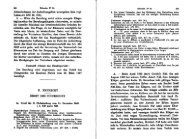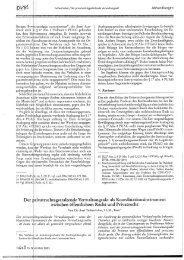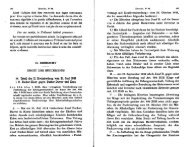Prozedurale Theorien der Gerechtigkeit - servat.unibe.ch
Prozedurale Theorien der Gerechtigkeit - servat.unibe.ch
Prozedurale Theorien der Gerechtigkeit - servat.unibe.ch
Sie wollen auch ein ePaper? Erhöhen Sie die Reichweite Ihrer Titel.
YUMPU macht aus Druck-PDFs automatisch weboptimierte ePaper, die Google liebt.
cc) Der Beoba<strong>ch</strong>ter<br />
Das Darstellungsmittel 'Beoba<strong>ch</strong>ter' präsentiert eine als Person geda<strong>ch</strong>te Beurteilungseinheit<br />
in <strong>der</strong> Außenperspektive 280 . Damit wird räumli<strong>ch</strong> und persönli<strong>ch</strong> die<br />
Befangenheit abgelegt, die alle übrigen Aktoren des Ges<strong>ch</strong>ehens haben. In einer Art<br />
Draufsi<strong>ch</strong>t o<strong>der</strong> Fernsi<strong>ch</strong>t nimmt <strong>der</strong> Beoba<strong>ch</strong>ter einen externen Standpunkt ein,<br />
sieht alles, ohne selbst beteiligt zu sein. Beoba<strong>ch</strong>tertheorien sind Standpunkttheorien<br />
und unters<strong>ch</strong>eiden si<strong>ch</strong> dadur<strong>ch</strong> von den Konsenstheorien, die auf Vertrag o<strong>der</strong> Diskurs<br />
Bezug nehmen 281 .<br />
Das (perspektivis<strong>ch</strong>e) Rationalitätskonzept 'Beoba<strong>ch</strong>ter' su<strong>ch</strong>t praktis<strong>ch</strong>e Erkenntnis<br />
in einem Zustand <strong>der</strong> Unvoreingenommenheit und Unparteili<strong>ch</strong>keit 282 . Das<br />
ri<strong>ch</strong>tigkeitsverbürgende Element liegt in <strong>der</strong> geda<strong>ch</strong>ten Überpersönli<strong>ch</strong>keit, die sogar<br />
das Ideal <strong>der</strong> Allwissenheit eins<strong>ch</strong>ließen kann 283 und jedenfalls die Befangenheit des<br />
Einzelnen in seiner neigungs- und interessengebundenen Identität dur<strong>ch</strong> ein Element<br />
Version of the Social Contract (1957), S. 663 f. –, wenn au<strong>ch</strong> als eine beson<strong>der</strong>e; ebd., S. 663:<br />
»Perhaps the most noticeable modification is its frank fictionalization«. Die in <strong>der</strong> Literatur kaum<br />
rezipierte Beoba<strong>ch</strong>tertheorie, in <strong>der</strong> Rawls statt von »consi<strong>der</strong>ed moral judgments« no<strong>ch</strong> von »competent<br />
moral judges« spri<strong>ch</strong>t, ers<strong>ch</strong>ien bereits 1951; J. Rawls, Outline of a Decision Procedure for<br />
Ethics (1951), S. 177 ff.<br />
280 So z.B. T. Nagel, View From Nowhere (1986), S. 185 ff.; S. Kagan, The Limits of Morality (1989), S.<br />
279 ff., 350 ff.; <strong>der</strong>s., Normative Ethics (1998), S. 41 ff., 271 ff.; vgl. die Charakterisierung bei C.S.<br />
Nino,The Ethics of Human Rights (1991), S. 74. Das Klassikervorbild für Beoba<strong>ch</strong>tertheorien bietet<br />
D. Hume, A Treatise of Human Nature, Bd. III: Of Morals (1740), Teil III, Abs<strong>ch</strong>nitt I: »[It is] impossible<br />
we cou'd ever converse together on any reasonable terms, were ea<strong>ch</strong> of us to consi<strong>der</strong><br />
<strong>ch</strong>aracters and persons, only as they appear from his peculiar point of view. In or<strong>der</strong>, therefore, to<br />
prevent those continual contradictions, and arrive at a more stable judgment of things, we fix on<br />
some steady and general points of views; and always, in our thoughts, place ourselves in them,<br />
whatever may be our present situation. ... Experience soon tea<strong>ch</strong>es us this method of correcting<br />
our sentiments« (Hervorhebung bei Hume). Ebenfalls als wirkmä<strong>ch</strong>tig erwies si<strong>ch</strong> die Beoba<strong>ch</strong>tertheorie<br />
von A. Smith, The Theory of Moral Sentiments (1759), Teil II, Kapitel II: »But these [gratitude<br />
and resentment] ... seem proper and are approved of, when the heart of every impartial spectator<br />
entirely sympathizes with them«; ebd., Fn.: »We conceive ourselves as acting in the presence<br />
of a person quite candid and equitable, of one who has no particular relation either to ourselves,<br />
or to those whose interests are affected by our conduct, ... but is merely a man in general, an impartial<br />
spectator who consi<strong>der</strong>s our conduct with the same indifference with whi<strong>ch</strong> we regard that<br />
of other people.«; ebd., Kapitel III: »We must view them [opposite interests], neither from our<br />
own place nor yet from his, neither with our own eyes nor yet with his, but from the place and<br />
with the eyes of a third person, who has no particular connexion with either, and who judges with<br />
impartiality between us.« Smith (ebd., Kapitel IV) bezieht si<strong>ch</strong> ausdrückli<strong>ch</strong> auf Hume als einen<br />
»ingenious and agreeable philosopher«.<br />
281 Vgl. A. Kaufmann, <strong>Prozedurale</strong> <strong>Theorien</strong> <strong>der</strong> <strong>Gere<strong>ch</strong>tigkeit</strong> (1989), S. 10 f. – Konsens als verbindendes<br />
Element von Vertrags- und Diskurstheorien im Gegensatz zu Standpunkttheorien.<br />
282 T. Nagel, Equality and Impartiality (1991), S. 10 ff.<br />
283 Beispielsweise K. Baier, Standpunkt <strong>der</strong> Moral (1958), S. 191: »Standpunkt eines ... Beoba<strong>ch</strong>ters ...<br />
gewissermaßen mit Gottes Augen«; C.S. Nino, The Ethics of Human Rights (1991), S. 74: »An ideal<br />
observer would be a hypothetical individual who was fully impartial, completely rational, aware<br />
of all the relevant facts, etc.« Vgl. zur »ideal observer theory« außerdem R.M. Hare, Rawls' Theory of<br />
Justice (1973), S. 89; S. Kagan, Normative Ethics (1998), S. 271 ff. Illustrativ aus <strong>der</strong> Literatur insoweit<br />
F. Dürrenmatt, Monstervortrag über <strong>Gere<strong>ch</strong>tigkeit</strong> (1969), S. 12 ff.<br />
100



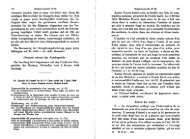
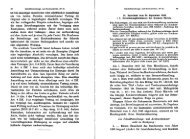
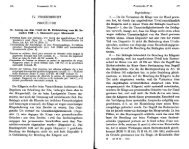
![Seminararbeit [Masterarbeit] - servat.unibe.ch - Universität Bern](https://img.yumpu.com/26241815/1/184x260/seminararbeit-masterarbeit-servatunibech-universitat-bern.jpg?quality=85)
